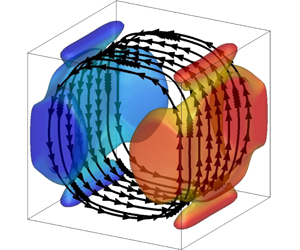Article contents
Reduced-order modelling of radiative transfer effects on Rayleigh–Bénard convection in a cubic cell
Published online by Cambridge University Press: 24 June 2020
Abstract

This paper presents a reduced-order modelling strategy for Rayleigh–Bénard convection of a radiating gas, based on the proper orthogonal decomposition (POD). Direct numerical simulation (DNS) of coupled natural convection and radiative transfer in a cubic Rayleigh–Bénard cell is performed for an  $\text{air}/\text{H}_{2}\text{O}/\text{CO}_{2}$ mixture at room temperature and at a Rayleigh number of
$\text{air}/\text{H}_{2}\text{O}/\text{CO}_{2}$ mixture at room temperature and at a Rayleigh number of  $10^{7}$. It is shown that radiative transfer between the isothermal walls and the gas triggers a convection growth outside the boundary layers. Mean and turbulent kinetic energy increase with radiation, as well as temperature fluctuations to a lesser extent. As in the uncoupled case, the large-scale circulation (LSC) settles in one of the two diagonal planes of the cube with a clockwise or anticlockwise motion, and experiences occasional brief reorientations which are rotations of
$10^{7}$. It is shown that radiative transfer between the isothermal walls and the gas triggers a convection growth outside the boundary layers. Mean and turbulent kinetic energy increase with radiation, as well as temperature fluctuations to a lesser extent. As in the uncoupled case, the large-scale circulation (LSC) settles in one of the two diagonal planes of the cube with a clockwise or anticlockwise motion, and experiences occasional brief reorientations which are rotations of  $\unicode[STIX]{x03C0}/2$ of the LSC in the horizontal plane. A POD analysis is conducted and reveals that the dominant POD eigenfunctions are preserved with radiation while POD eigenvalues are increased. Two POD-based reduced-order models including radiative transfer effects are then derived: the first one is based on coupled DNS data while the second one is an a priori model based on uncoupled DNS data. Owing to the weak temperature differences, radiation effects on mode amplitudes are linear in the models. Both models capture the increase in energy with radiation and are able to reproduce the low-frequency dynamics of reorientations and the high-frequency dynamics associated with the LSC velocity observed in the coupled DNS.
$\unicode[STIX]{x03C0}/2$ of the LSC in the horizontal plane. A POD analysis is conducted and reveals that the dominant POD eigenfunctions are preserved with radiation while POD eigenvalues are increased. Two POD-based reduced-order models including radiative transfer effects are then derived: the first one is based on coupled DNS data while the second one is an a priori model based on uncoupled DNS data. Owing to the weak temperature differences, radiation effects on mode amplitudes are linear in the models. Both models capture the increase in energy with radiation and are able to reproduce the low-frequency dynamics of reorientations and the high-frequency dynamics associated with the LSC velocity observed in the coupled DNS.
JFM classification
- Type
- JFM Papers
- Information
- Copyright
- © The Author(s), 2020. Published by Cambridge University Press
References
- 13
- Cited by


